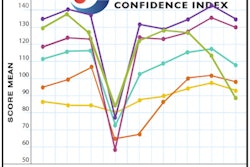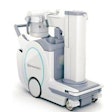
PHOENIX - When it comes to managing imaging assets, the last thing you want as a radiology administrator is to suddenly realize you need millions of dollars for new capital equipment. Keeping track and having a strategic plan in place is key, according to a July 10 presentation at the AHRA 2022 meeting.
 Jason Newmark.
Jason Newmark.Jason Newmark of Boston's ECG Management Consultants provided AHRA 2022 attendees with insights on developing a baseline multiyear, system-wide medical imaging capital plan.
"This shouldn't be a one-time event. You should be keeping track of your assets at all times. If not, the next thing you know is you wake up and need $30 million in imaging equipment," Newmark said.
Get a team together
Establishing a project team is the first step of a successful initiative, Newmark said. The team should prioritize consistent communication and meet regularly throughout the project to ensure transparency and collaboration. The key is to appoint a dedicated leader and to make sure the team is multidisciplinary. Important members include people with technical, clinical, and administrative expertise who can offer advice on ease-of-use, workflows, training, and standardization, he said.
With a team in place, next comes developing a complete and accurate technology inventory, a list that includes the age of the asset, its operating system lifecycle, its condition rating based on usefulness, and service history.
Again, sometimes this step comes with surprises. Some administrators may find themselves asking, "When did we get that [equipment]?" Newmark said.
Build in your current system use, volume, procedure mix, staffing, hours of operation, and exam times, Newmark said. A review of high-level workflow may be undertaken to identify bottlenecks, delays, and inefficiencies that can be improved when new equipment is installed.
Also, understanding the strategic and future market demands related to volume projections and future capital requirements is essential, as strategic capital plans need to consider future technology requirements.
"Your planning horizon should be at least three years out," Newmark added.
It's RFP time
Writing a request for proposal (RFP) is a special skill, and resources are available for mastering it. Essentially, however, a highly structured RFP for imaging capital equipment should include the following:
- Clearly outline key dates, key deliverables, and standard terms.
- Articulate the size of the opportunity.
- Identify the project team: the vendor should understand senior leadership is involved.
- Share an overview of strategic considerations and priorities.
- Define the criteria for selection.
- Establish a single point of contact for the health system.
- Require vendors to submit their proposals in a standardized, sortable spreadsheet.
"Include service quote requests for each system and modality, and request value-adds above just transactional items," Newmark added.
When it comes to comparative analysis across vendors, it is important to account for total cost of ownership when comparing bids and proposals, Newmark said. For example, in working up a cost of ownership comparison for a 1.5-tesla MRI scanner between Philips, Siemens Healthineers, and GE Healthcare, the initial acquisition may appears higher for a scanner from one vendor, but over 10 years and including post-warranty service plan costs, the same scanner is among the lowest (by about $200,000), Newmark said.
Also, for larger systems, look for rigging charges, and make sure these costs are accounted for in the replacement budget, he added.
Case study
Newmark offered a case study based on his firm's work with Baystate Health, one of the largest academic health systems in New England, located in western Massachusetts. The five-hospital system serves a population of 800,000 and performs more than 450,000 exams per year on about 120 distinct imaging devices in radiology.
Implementing steps he outlined during the AHRA session bore multiple rounds of bidding and resulted in highly competitive bids that yielded substantial pricing concessions ($11 million) over group purchasing organization (GPO) entitlement pricing, he said.
In terms of relationships with vendors, Baystate Health sought one that had a partnership feel rather than a simple transactional relationship, and it bore fruit, Newmark said. The system now has an enhanced onsite vendor presence for application training and operational support and vendor-led leadership development courses onsite and at the vendor's campus.
Ultimately, imaging assets are a significant expense to any organization, usually second only to labor, Newmark said. The bottom line is that strategic capital plans should bear results that are on time, on budget, and that meet their forecast.
"That is the recipe for budget approval the next time," he concluded.




















